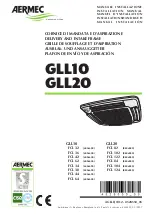
Installation manual
3
FDYP125~2 FDQ125~250B8V3B
Split System air conditioners
4PW23694-1A
I
NDOOR
UNIT
INSTALLATION
When installing optional accessories, refer to the instruction manual
of each optional accessory. Depending on the field conditions, it may
be easier to install optional accessories before the indoor unit is
installed.
1.
Install the indoor unit temporarily.
Attach the hanger bracket to the suspension bolt. Be sure to fix it
securely by using a nut and washer from the upper and lower
sides of the hanger bracket.
2.
Do not install the unit tilted.
(If the unit is tilted against condensate flow, water can drip out of
the drain pan).
Check if the unit is levelled at all four corners with a water level (1) or
a water-filled vinyl tube (2) (Refer to
3.
Tighten the upper nut.
4.
An air filter is installed to prevent dust accumulation on the heat
exchanger. This will prolong the lifetime of the unit.
5.
Connect the air inlet to the air inlet ducting and the air outlet to
the air outlet ducting. Always provide a flexible connection
between the ducting flanges of the air conditioner and the ducts
to prevent vibrations and noise generation.
R
EFRIGERANT
PIPING
WORK
For refrigerant piping of outdoor unit, see the installation manual
attached to the outdoor unit.
When installing field piping, take the following items into
consideration:
■
The outdoor unit is charged with refrigerant.
■
Use a pipe cutter and flare suitable for the used refrigerant.
■
The liquid line must be connected to the air conditioning unit via
a flare connection. The gas line must be welded directly to the
air conditioning unit piping. In case of a 125 unit, both the liquid
line and the gas line must be connected to the air conditioning
via a flare connection.
■
In case of flare connections, flare the pipe end neatly to avoid
refrigerants leaks.
■
Be sure to use both a spanner and torque wrench together when
connecting or disconnecting pipes to/from the unit (Refer to
■
Refer to the table below for the dimensions of flare nut spaces.
■
Because R407C/R410A refrigerant is used, apply ether or ester
oil around the flare portions before connecting.
Coat here with ether oil or ester oil
■
Refer to the table above to determine the proper tightening
torque. (Overtightening may damage the flare and cause leaks.)
■
Check the pipe connector for gas leaks.
■
Only wrap the gas line side of the insulation for fitting (union)
with the sealing pad (attached).
■
Use copper alloy seamless pipes (ISO 1337).
V
ACUUM
DRYING
OF
INSTALLATION
Refer to the installation manual of the outdoor unit.
D
RAIN
PIPING
WORK
Ensure that a protective guard is installed in front of the air
outlet to prevent that the fan blades can be touched. The
protection must comply with relevant local and national
regulations.
All field piping (liquid line and gas line between the
condensing and the air conditioning unit) must be installed
by a licensed refrigeration technician and must comply with
relevant local and national regulations.
1
Piping union
2
Spanner
3
Flare nut
4
Torque wrench
1
2
3
1
Field procurement.
2
Washer for hanger bracket
3
Tighten (double nut)
Pipe
gauge
Tightening torque
Flare dimension A (mm)
Flare shape
R407C
R410A
Ø6.4
14.2~17.2 N•m
(144~176 kgf•cm)
8.3~8.7
8.7~9.1
Ø9.5
32.7~39.9 N•m
(333~407 kgf•cm)
12.0~12.4
12.8~13.2
Ø12.7
49.5~60.3 N•m
(504~616 kgf•cm)
15.4~15.8
16.2~16.6
Ø15.9
61.8~75.4 N•m
(630~770 kgf•cm)
18.6~19.0
19.3~19.7
Ø19.1
97.2~118.6 N•m
(990~1210 kgf•cm)
22.9~23.3
—
■
Arrange the drain hose to ensure smooth drainage.
Incomplete drainage may cause the building to
become wet.
■
The drain hose must slope downward to the outdoor
side.
■
Never put the end of the drain into water.
■
A trap to prevent bad odours is allowed.
■
If you extend the drain hose always insulate it up to
the outdoor side with polyethylene foam insulation
material (field supplied).
■
To ensure a downward slope of minimum 1:100,
install hanging bars every 1 to 1.5 m.
■
If unifying multiple drain pipes, install pipes shown in
the figure above.
R0.4~0.8
45
° ±
2
90
°±
2
A
≥
100




























